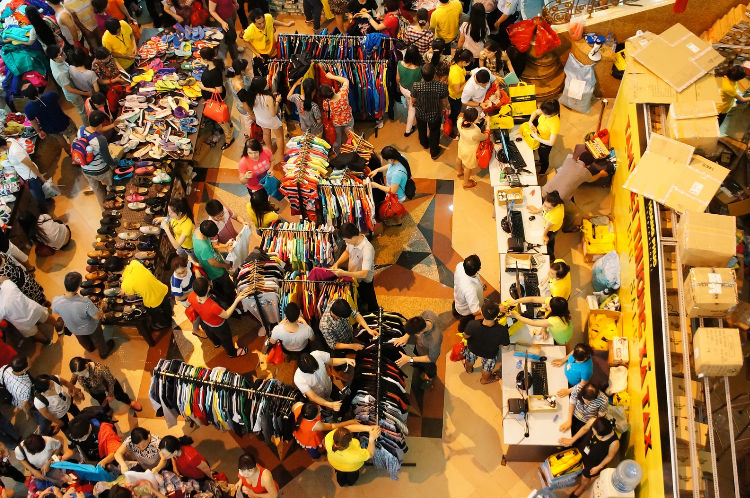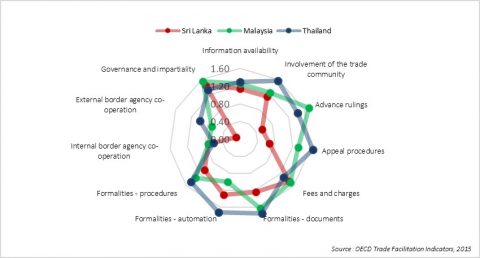September 25, 2017 Reading Time: 17 minutes

Reading Time: 17 min read
Image Credit – xuanhuongho / depositphotos
Dinuka Malith and Anishka De Zylva*
This LKI Explainer explains key aspects of the Trade Facilitation Agreement (TFA),1 which entered into force in February 2017. It also considers implications of this Agreement for Sri Lanka.
Assistance under the TFA
Special and Differential Treatment Provisions
The Committee on Trade Facilitation
Assistance via the WTO
Trade Facilitation Agreement Facility
Assistance by External Organisations
Trade Facilitation Support Program
The Global Alliance for Trade Facilitation
Sri Lanka’s need for trade facilitation
Figure 1: A Comparison of Sri Lanka, Malaysia, and Thailand’s Trade Facilitation Indicators

Sri Lanka’s implementation of the TFA
Commitments under the TFA
National Trade Facilitation Committee
Assistance to implement the TFA
Figure 2: A country comparison of the number of days taken to import or export
Expected benefits of the TFA for Sri Lanka
Dua, K. and Abbas, S. (2010). Plurilateralism and Trade Facilitation: The Way Ahead for Intraregional Trade in South Asia. Asian Journal of Public Affairs, 3, 2, pp. 3-19.
Portugal-Perez, A. and Wilson, J. (2010). Export Performance and Trade Facilitation Reform: Hard and Soft Infrastructure. Available at: http://documents.worldbank.org/curated/en/232901468322759221/pdf/WPS5261.pdf#page=4.
World Trade Organization (2017). National Committees on Trade Facilitation: Current Practices and Challenges. Trade Facilitation: Experience Sharing Series. Available at: https://www.tfafacility.org/sites/default/files/news/tfa_national_committees_trade_facilitation_web_e.pdf.
World Trade Organization. (2014). Agreement on Trade Facilitation. Available at: https://www.wto.org/english/docs_e/legal_e/tfa-nov14_e.htm.
World Trade Organization. (2015). Speeding Up Trade: Benefits and Challenges of Implementing the WTO Trade Facilitation Agreement. Available at: https://www.wto.org/english/res_e/booksp_e/world_trade_report15_e.pdf.
i A single window allows traders to submit all import, export, and transit information required by regulatory agencies via a single electronic gateway, instead of submitting it multiple times to various government entities.
ii Multi-container consolidation or multi-country consolidation means consolidating cargo from different countries of origin to build Full Container Load freights.
iii Time taken to export is the sum of border compliance hours and documentary compliance hours.
iv Time taken to import is the sum of border compliance hours and documentary compliance hours.
1 World Trade Organization. (2014). Agreement on Trade Facilitation. Available at: https://www.wto.org/english/docs_e/legal_e/tfa-nov14_e.htm.
2 World Trade Organization. (2013). Agreement on Trade Facilitation Ministerial Decision of 7 December 2013. Available at: https://www.wto.org/english/thewto_e/minist_e/mc9_e/bali_texts_combined_e.pdf#page=11.
3 Trade Facilitation Agreement Facility. (n.d.). Operational Guidelines. Available at: http://www.tfafacility.org/operational-guidelines.
4 World Trade Organization. (n.d.). Ninth WTO Ministerial Conference: Briefing Notes. Available at: https://www.wto.org/english/thewto_e/minist_e/mc9_e/balipackage_e.htm.
5 World Trade Organization. (2014). Agreement on Trade Facilitation. Available at: https://lki.lk/wp-content/uploads/2017/09/WTO_Agreement-on-Trade-Facilitation.pdf
6 World Trade Report 2015. (2015). Estimating the benefits of the Trade Facilitation Agreement. Available at: https://www.wto.org/english/res_e/booksp_e/world_trade_report15_e.pdf#page=75.
7 World Trade Report 2015. (2015). Estimating the benefits of the Trade Facilitation Agreement. Available at: https://www.wto.org/english/res_e/booksp_e/world_trade_report15_e.pdf#page=80.
8 World Trade Organization. (2015). World Trade Report 2015. Available at: https://www.wto.org/english/res_e/booksp_e/world_trade_report15_e.pdf#page=80.
9 Ibid.
10 World Trade Organization. (2015). World Trade Report 2015. Available at: https://www.wto.org/english/res_e/booksp_e/world_trade_report15_e.pdf#page=90.
11 Ibid.
12 Ibid.
13 Ibid.
14 Ibid.
15 World Trade Organization. (2015). Easing the Flow of Goods Across Borders: Trade Facilitation Agreement. Available at: https://www.wto.org/english/thewto_e/20y_e/wto_tradefacilitation_e.pdf#page=2.
16 World Trade Organization. (2014). Agreement on Trade Facilitation. Available at: https://www.wto.org/english/docs_e/legal_e/tfa-nov14_e.htm#art24.
17 World Trade Organization. (2014). Agreement on Trade Facilitation. Available at: https://www.wto.org/english/docs_e/legal_e/tfa-nov14_e.htm#art13.
18 Ibid.
19 World Trade Organization. (2017). WTO’s Trade Facilitation Agreement Enters into Force. Available at: https://www.wto.org/english/news_e/news17_e/fac_31jan17_e.htm.
20 World Trade Organization. (2017). Trade Facilitation Agreement Database. Available at: https://www.tfadatabase.org/.
21 Trade Facilitation Agreement Facility. (2017). Ratifications. Available at: http://www.tfafacility.org/ratifications.
22 World Trade Organization. (2014). Agreement on Trade Facilitation. Available at: https://www.wto.org/english/docs_e/legal_e/tfa-nov14_e.htm#art1.
23 World Trade Organization. (2014). Agreement on Trade Facilitation. Available at: https://www.wto.org/english/docs_e/legal_e/tfa-nov14_e.htm#art2.
24 World Trade Organization. (2014). Agreement on Trade Facilitation. Available at: https://www.wto.org/english/docs_e/legal_e/tfa-nov14_e.htm#art3.
25 World Trade Organization. (2014). Agreement on Trade Facilitation. Available at: https://www.wto.org/english/docs_e/legal_e/tfa-nov14_e.htm#art4.
26 World Trade Organization. (2014). Agreement on Trade Facilitation. Available at: https://www.wto.org/english/docs_e/legal_e/tfa-nov14_e.htm#art5.
27 The World Trade Organization. (2014). Agreement on Trade Facilitation. Available at: https://www.wto.org/english/docs_e/legal_e/tfa-nov14_e.htm#art6.
28 The World Trade Organization. (2014). Agreement on Trade Facilitation. Available at: https://www.wto.org/english/docs_e/legal_e/tfa-nov14_e.htm#art7.
29 The World Trade Organization. (2014). Agreement on Trade Facilitation. Available at: https://www.wto.org/english/docs_e/legal_e/tfa-nov14_e.htm#art8.
30 The World Trade Organization. (2014). Agreement on Trade Facilitation. Available at: https://www.wto.org/english/docs_e/legal_e/tfa-nov14_e.htm#art9.
31 The World Trade Organization. (2014). Agreement on Trade Facilitation. Available at: https://www.wto.org/english/docs_e/legal_e/tfa-nov14_e.htm#art10.
32 The World Trade Organization. (2014). Agreement on Trade Facilitation. Available at: https://www.wto.org/english/docs_e/legal_e/tfa-nov14_e.htm#art11.
33 The World Trade Organization. (2014). Agreement on Trade Facilitation. Available at: https://www.wto.org/english/docs_e/legal_e/tfa-nov14_e.htm#art12.
34 The World Trade Organization. (2014). Agreement on Trade Facilitation. Available at: https://www.wto.org/english/docs_e/legal_e/tfa-nov14_e.htm#art23.
35 Portugal-Perez, A. and Wilson, J. (2010). Export Performance and Trade Facilitation Reform: Hard and Soft Infrastructure. Available at: http://documents.worldbank.org/curated/en/232901468322759221/pdf/WPS5261.pdf#page=4.
36 Ibid.
37 The World Trade Organization. (2014). Agreement on Trade Facilitation. Available at: https://www.wto.org/english/docs_e/legal_e/tfa-nov14_e.htm#art13.
38 The World Trade Organization. (2014). Agreement on Trade Facilitation. Available at: https://www.wto.org/english/docs_e/legal_e/tfa-nov14_e.htm#art14.
39 The World Trade Organization. (2014). Agreement on Trade Facilitation. Available at: https://www.wto.org/english/docs_e/legal_e/tfa-nov14_e.htm#art15/.
40 Trade Facility Database. (2014). Notification of Category A Commitments Under the Agreement on Trade Faciitation. Available at: https://www.tfadatabase.org/uploads/notification/NLKA1.pdf.
41 The World Trade Organization. (2014). Agreement on Trade Facilitation. Available at: https://www.wto.org/english/docs_e/legal_e/tfa-nov14_e.htm#art16.
42 The Trade Facilitation Agreement Database. (2017). Notification of Category Commitments Under the Agreement on Trade Facilitation: Communication from Botswana. Available at: https://www.tfadatabase.org/uploads/notification/NBWA1_3.pdf.
43 The World Trade Organization. (2014). Agreement on Trade Facilitation. Available at: https://www.wto.org/english/docs_e/legal_e/tfa-nov14_e.htm#art16.
44 Trade Facilitation Agreement Database. (2016). Notification of Category A, B, and C Commitments Under the Agreement on Trade Facilitation: Communication from Zambia. Available at: https://www.tfadatabase.org/uploads/notification/NZMB1.pdf#page=3.
45 The World Trade Organization. (2014). Agreement on Trade Facilitation. Available at: https://www.wto.org/english/docs_e/legal_e/tfa-nov14_e.htm#art8.
46 The World Trade Organization. (2014). Agreement on Trade Facilitation. Available at: https://www.wto.org/english/docs_e/legal_e/tfa-nov14_e.htm#art16.
47 Trade Facilitation Agreement Facility. (2017). Donors and Organizations. Available at: http://www.tfafacility.org/implementation-support.
48 The World Trade Organization. (2014). Agreement on Trade Facilitation. Available at: https://www.wto.org/english/docs_e/legal_e/tfa-nov14_e.htm#art21.
49 The World Trade Organization. (2014). Agreement on Trade Facilitation. Available at: https://www.wto.org/english/docs_e/legal_e/tfa-nov14_e.htm#art23.
50 Ibid.
51 Ibid.
52 Trade Facilitation Agreement Facility. (2017). About the Facility. Available at: http://www.tfafacility.org/about-the-facility.
53 Ibid.
54 Ibid.
55 Ibid.
56 Ibid.
57 Trade Facilitation Agreement Facility. (n.d.). Trade Facilitation Agreement Facility Grants. Available at: http://www.tfafacility.org/tfaf-grants.
58 Ibid.
59 Portugal-Perez, A. and Wilson, J. (2010). Export Performance and Trade Facilitation Reform: Hard and Soft Infrastructure. Available at: http://documents.worldbank.org/curated/en/232901468322759221/pdf/WPS5261.pdf#page=4.
60 Trade Facilitation Agreement Facility. (n.d.). Annual Report 2016. Available at: http://www.tfafacility.org/annual-report-2016#Funds.
61 The World Bank. (n.d.). Trade Facilitation Support Program. Available at: http://www.worldbank.org/en/programs/trade-facilitation-support-program.
62 The World Bank. (n.d.). Trade Facilitation Support Program. Available at: http://www.worldbank.org/en/programs/trade-facilitation-support-program#4.
63 Ibid.
64 World Bank. (n.d.). Trade Facilitation Support Program. Available at: http://www.worldbank.org/en/programs/trade-facilitation-support-program#2.
65 The World Bank. (n.d.). Trade Facilitation Support Program. Available at: http://www.worldbank.org/en/programs/trade-facilitation-support-program#3.
66 The Global Alliance for Trade Facilitation. (n.d.). About the Alliance. Available at: http://www.tradefacilitation.org/about-the-alliance.html.
67 Ibid.
68 The Global Alliance for Trade Facilitation. (n.d.). Frequently Asked Questions: What is the Global Alliance for Trade Facilitation?. Available at: http://www.tradefacilitation.org/faq.html.
69 Ibid.
70 Ibid.
71 Portugal-Perez, A. and Wilson, J. (2010). Export Performance and Trade Facilitation Reform: Hard and Soft Infrastructure. Available at: http://documents.worldbank.org/curated/en/232901468322759221/pdf/WPS5261.pdf#page=27.
72 The World Trade Organization. (2014). Agreement on Trade Facilitation. Available at: https://www.wto.org/english/docs_e/legal_e/tfa-nov14_e.htm#annex1.
73 Ghosh, J. (2014). India faces criticism for blocking global trade deal, but is it justified?. The Guardian. Available at: https://www.theguardian.com/global-development/poverty-matters/2014/aug/22/india-criticism-blocking-global-trade-deal.
74 Ibid.
75 Global Trade Alert. (2017). Global Dynamics. Available at: http://www.globaltradealert.org/global_dynamics.
76 Elliott, L. (2013). Bali trade agreement: WTO set the bar high but has achieved little. The Guardian. Available at: https://www.theguardian.com/business/economics-blog/2013/dec/06/wto-development-deal-two-decades.
77 McClanahan, P. (2013). Trade facilitation: breaking down barriers to international commerce. The Guardian. Available at: https://www.theguardian.com/global-development/2013/apr/22/trade-facilitation-barriers-international-commerce.
78 Trade Facilitation Agreement Facility. (2017). Ratifications. Available at: http://www.tfafacility.org/ratifications.
79 OECD Trade Facilitation Indicators. (2017). Compare Your Country. Available at: http://www.oecd.org/trade/facilitation/indicators.htm.
80 The World Trade Organization. (2015). World Trade Report 2015. Available at: https://www.wto.org/english/res_e/booksp_e/world_trade_report15_e.pdf#page=80.
81 Wijayasiri, J. (2016). Trade is Not Just for Big Businesses: Role of Sri Lankan SMEs in Trade. DailyFT. Available at: http://www.ips.lk/talkingeconomics/2016/11/28/trade-is-not-just-for-big-businesses-role-of-sri-lankan-smes-in-trade/.
82 Ibid.
83 Trade Facilitation Agreement Database. (2017). Member Profile: Sri Lanka. Available at: https://www.tfadatabase.org/members/sri-lanka.https://www.tfadatabase.org/members/sri-lanka.
84 Ibid.
85 United Nations Conference on Trade and Development. (2017). Trade Facilitation Body: The Case of Sri Lanka. Available at: http://unctad.org/en/DTL/TLB/Pages/TF/Committees/detail.aspx?country=LK.
86 Ibid.
87 Economy Next. (2016). Sri Lanka Customs ‘Single Window’ Seen Reducing Costs. Available at: http://economynext.com/Sri_Lanka_Customs_%E2%80%98Single_Window%E2%80%99_seen_reducing_costs-3-3977-1.html.
88 Word Customs Organization. (n.d.). Case Study National Committee on Trade Facilitation Sri Lanka. Available at: http://www.wcoomd.org/-/media/wco/public/global/pdf/topics/wto-atf/national-committees-on-trade-facilitation/case-study_sri-lanka-rev-en.pdf?la=en#page=2.
89 Trade Facilitation Agreement Facility. (2017). National Committees on Trade Facilitation: Current Practices and Challenges. Available at: https://www.tfafacility.org/sites/default/files/news/tfa_national_committees_trade_facilitation_web_e.pdf#page=27.
90 Trade Facilitation Agreement Facility. (2017). National Committees on Trade Facilitation: Current Practices and Challenges. Available at: https://www.tfafacility.org/sites/default/files/news/tfa_national_committees_trade_facilitation_web_e.pdf#page=25.
91 Trade Facilitation Agreement Facility. (2017). Sri Lanka. Available at: http://www.tfafacility.org/sri-lanka.
92 Landmark Agreement Enters into Force. (2017). World Bank Group Trade Facilitation Support Program Newsletter, (Volume 1, Number 1), p.2. Available at: http://pubdocs.worldbank.org/en/404991487774360163/TFSP-Newsletter-vol-1-v9.pdf#page=2.
93 The Global Alliance for Trade Facilitation. (2017). The Alliance on the Ground. Available at: http://www.tradefacilitation.org/the-alliance-on-the-ground.html.
94 Ibid.
95 Ibid.
96 Aid for Trade. (2017). Sri Lanka: Aid for Trade at a Glance 2017. Available at: http://www.oecd.org/aidfortrade/countryprofiles/Sri_Lanka.pdf.
97 Ibid.
98 Aid for Trade. (2015). Nepal: Aid for Trade at a Glance 2015. Available at: http://www.oecd.org/aidfortrade/countryprofiles/Nepal.pdf.
99 Aid for Trade. (2015). Bangladesh: Aid for Trade at a Glance 2015. Available at: http://www.oecd.org/aidfortrade/countryprofiles/Bangladesh.pdf.
100 World Bank Group. (2017). Trading Across Borders: Doing Business Indicators. Available at: http://www.doingbusiness.org/data/exploretopics/trading-across-borders.
101 International Trade Centre. (2011). Sri Lanka: Company Perspectives. An ITC Series on Non-Tariff Measures. Available at: http://www.intracen.org/uploadedFiles/intracenorg/Content/Publications/NTM%20Report_Sri%20Lanka.pdf#page=45
102 Daily FT. (2016). EU, UN launch Rs. 1 billion Project to Boost SL trade. Available at: http://www.ft.lk/article/580291/EU–UN-launch–Rs–1-billion-project-to-boost-SL-trade.
103 World Trade Organization. (2015). World Trade Report 2015. Available at: https://www.wto.org/english/res_e/booksp_e/world_trade_report15_e.pdf#page=137.
104 Albert, E. (2016). Competition in the Indian Ocean. Council on Foreign Relations. Available at: https://www.cfr.org/backgrounder/competition-indian-ocean.
105 OECD. (2017). Aid for Trade Facilitation Data. Available at: http://www.oecd.org/aidfortrade/data/aidfortradefacilitation.htm.
106 Ibid.
107 Trade Facilitation Agreement Facility. (2017). National Committees on Trade Facilitation: Current Practices and Challenges. Available at: https://www.tfafacility.org/sites/default/files/news/tfa_national_committees_trade_facilitation_web_e.pdf#page=18.
108 Vietnam Customs. (2016). Action Plan for Implementation of Commitments under the WTO Trade Facilitation Agreement. Available at: https://www.customs.gov.vn/Lists/EnglishNews/ViewDetails.aspx?ID=515&Category=News%20and%20Events&language=en-US.
109 Trade Facilitation Agreement Facility. (n.d.). Annual Report 2016: Matchmaking and Funding Activities. Available at: http://www.tfafacility.org/annual-report-2016#Matchmaking and Funding Activities.
Abbreviations
FDI Foreign Direct Investment
GDP Gross Domestic Product
GVCs Global Value Chains
LDCs Least Developed Countries
NTFC National Trade Facilitation Committee
OECD Organisation for Economic Co-operation and Development
SMEs Small and Medium-Size Enterprises
TFA Trade Facilitation Agreement
TFAF Trade Facilitation Agreement Facility
TFSP Trade Facilitation Support Program
WTO World Trade Organization
*Dinuka Malith was a Research and Communications Assistant at the Lakshman Kadirgamar Institute of International Relations and Strategic Studies (LKI) in Colombo, and Anishka De Zylva is a Research Associate at LKI. The authors acknowledge the assistance of Amjad Hamza, Research and Communications Assistant, and of other colleagues at LKI. The opinions expressed in this publication, and any errors or omissions, are the authors’ own.